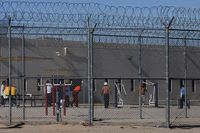In a troubling trend that has caught the attention of human rights advocates and medical professionals alike, nearly 14,000 immigrants have been placed in solitary confinement in detention centers across the United States between April 2024 and August 2025, according to a new report by Harvard University researchers and Physicians for Human Rights. The report, which draws on data from U.S. Immigration and Customs Enforcement (ICE), reveals a significant rise in both the number and duration of solitary confinement placements, particularly among those considered most vulnerable.
For many, the very mention of solitary confinement conjures up images of extreme isolation and psychological distress. But for thousands of immigrants—including asylum seekers and those awaiting court hearings—this reality is anything but abstract. According to Axios, the researchers found that solitary confinement, once considered a last resort, is being used more frequently and for longer periods, with some placements dragging on for weeks at a time. The United Nations, notably, classifies solitary confinement lasting 15 days or more as a form of psychological torture.
The report's numbers are stark: Texas alone accounted for about 25% of all solitary confinement placements, with approximately 3,500 individuals subjected to isolation in the state during the 16-month period studied. Pennsylvania followed with roughly 2,400 cases. The Moshannon Valley Processing Center in Philipsburg, Pennsylvania, reported the highest number of people isolated—1,905 through May 2025. The Montgomery Processing Center in Conroe, Texas, came next with 1,075, followed by the Buffalo Service Processing Center in Batavia, New York, and the South Texas ICE Processing Center in Pearsall, Texas, with 642 and 488 cases, respectively.
What stands out most alarmingly is the plight of detainees labeled as "vulnerable"—a group that includes individuals with mental health conditions and other special needs. Between April 2024 and May 2025, these vulnerable detainees made up about one-fifth of those placed in solitary. In the first three months of 2025, they were kept in isolation for an average of 38 days, a dramatic jump from the 14-day average reported in 2021. This escalation, experts warn, is not only a humanitarian concern but potentially a violation of both U.S. and international law.
Sam Zarifi, executive director of Physicians for Human Rights, did not mince words when speaking to Axios. "We are torturing people simply because they want a better life in the U.S.," Zarifi said. He went on to argue that such treatment is not only horrific but also a clear breach of legal and ethical standards. "ICE detention facilities are systemically torturing people and are on track to be torturing more people, and these are people who are not imprisoned for criminal activity. They are asylum seekers and immigrants."
The report, released in early October 2025 and covered by both Axios and the Latin Times, underscores the complex and often opaque nature of solitary confinement in the immigration system. The researchers focused on ICE-operated and ICE-contracted facilities, which are intended to hold immigrants temporarily while they await court hearings or check-ins—not as a form of punishment for immigration violations. Yet, the data suggest that isolation is being used far more broadly than intended, especially in state and county jails that contract with ICE.
ICE's own directives are clear: solitary confinement should only be used on people with mental health conditions as a last resort. But the reality on the ground appears to diverge sharply from this policy. The Harvard and Physicians for Human Rights report found that vulnerable individuals are often subjected to weeks-long isolation, which can have devastating psychological effects. The United Nations' designation of solitary confinement over 15 days as psychological torture only adds to the gravity of the findings.
Adding another layer of concern, the researchers warn that ICE's data is typically incomplete, leading to a likely undercount of the true number of solitary confinement placements. In other words, the situation may be even worse than the already grim statistics suggest. "ICE data is usually undercounted, and the real figure could be much higher," the Latin Times reported, echoing the study's caution about the reliability of official numbers.
Some facilities and state officials have pushed back against the characterization of their practices as solitary confinement. In Massachusetts, for example, officials claim to have moved away from traditional solitary in favor of "administrative segregation." This approach, they say, separates detainees believed to pose a threat but allows for regular interaction with staff clinicians and, at times, other inmates. Detainees in administrative segregation are said to have daily access to mental health clinicians. However, prisoner advocates are skeptical, arguing that administrative segregation is little more than a euphemism for the same harsh practice, with only minimal differences.
The debate over terminology may seem academic, but for those experiencing prolonged isolation, the consequences are anything but theoretical. Advocates point out that the lack of meaningful contact, combined with the uncertainty of detention, can exacerbate existing mental health issues and lead to long-term psychological harm. As the report notes, the use of solitary confinement on vulnerable populations is particularly troubling, given their heightened risk of negative outcomes.
With ICE declining to comment despite multiple requests from Axios, the spotlight now turns to state and local officials, many of whom have the authority to shape detention practices in facilities under their jurisdiction. The Harvard and Physicians for Human Rights report urges these officials to take proactive steps: ending or reducing solitary confinement in local facilities with ICE contracts, conducting unplanned facility inspections, and ensuring that detainees have access to legal representation, interpreters, and due process protections.
As the United States grapples with ongoing debates over immigration policy and the treatment of migrants, the findings of this report raise pressing questions about the nation's commitment to human rights and the rule of law. Are these practices a necessary tool for maintaining order in detention centers, or do they cross a line into cruel and inhumane treatment? For now, the data paints a sobering picture—one that demands attention from policymakers, advocates, and the public alike.
With the number of solitary confinement placements rising and vulnerable individuals bearing the brunt of the practice, the call for reform grows louder. As Sam Zarifi put it, "We are torturing people simply because they want a better life in the U.S." Whether that call will be heeded remains to be seen, but the evidence presented leaves little doubt about the urgency of the issue.




